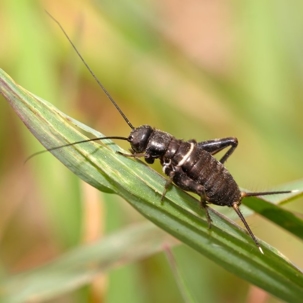Crickets vs Grasshoppers
Crickets and grasshoppers are both insects in the order Orthoptera, but they differ in physical characteristics, behavior, habitat, and life cycles:
Physical Appearance
Crickets: Usually darker in color, ranging from brown to black. Body is more flattened and elongated. Antennae are very long—often longer than the body. Hind legs are long but generally less robust than grasshoppers. Wings, if present, lie flat over the body.
Grasshoppers: Often green, brown, or a mix, usually camouflaged with their environment. Body is stouter and more cylindrical. Antennae are shorter, usually about half the body length. Hind legs are very strong, built for jumping long distances. Wings are usually longer and may cover the abdomen.
Sound Production
Crickets: Produce sound by stridulation, rubbing their forewings together. Chirping is mainly at night to attract mates. Sound is softer and more melodic, often associated with nighttime.
Grasshoppers: Produce sound by rubbing hind legs against forewings or sometimes via wings. Usually active during the day (diurnal). Sound is louder, harsher, and rhythmic, often associated with fields or grasslands.
Activity Patterns
Crickets: Mostly nocturnal, hiding during the day in cracks, under leaves, or in soil. Prefer moist environments.
Grasshoppers: Mostly diurnal, active during the day. Prefer dry, open areas, like fields and grasslands.
Diet
Crickets: Omnivorous: eat plants, decaying organic matter, fungi, and even small insects. Can adapt to indoor environments (house crickets eat crumbs and paper products).
Grasshoppers: Primarily herbivorous: eat grasses, leaves, and crops. Major agricultural pests due to their plant-eating habits.
Habitat
Crickets: Prefer dark, moist places like soil, under rocks, inside buildings, or leaf litter. Some species are fully domestic, living in houses.
Grasshoppers: Prefer open sunny areas, like meadows, prairies, and agricultural fields. Rarely enter homes.
Reproduction and Life Cycle
Crickets: Eggs are laid in soil or soft material. Nymphs resemble adults but are smaller, undergo gradual metamorphosis (incomplete).
Grasshoppers: Eggs are laid in soil pods. Nymphs also undergo incomplete metamorphosis, growing through several molts.
Lifespan
Crickets: Typically live a few months, depending on species and environment.
Grasshoppers: Usually live one season, hatching in spring and dying after reproduction in late summer or fall.
Behavior
Crickets: Tend to hide and chirp at night, more solitary. Often attracted to lights or food indoors.
Grasshoppers: Tend to jump or fly to escape threats, more active in groups, sometimes forming swarms.
Body Structure & Adaptations
Crickets: More flattened bodies, adapted to hide in narrow cracks or under debris. Legs are strong but optimized for short jumps rather than long-distance leaping. Wings are often shorter or sometimes absent in females, depending on the species.
Grasshoppers: Stout, cylindrical bodies, suited for long-distance jumping and gliding flights. Hind legs are extremely muscular for escaping predators. Wings are usually well-developed, enabling sustained flight.
Communication & Behavior
Crickets: Chirp primarily to attract mates. Sound frequency can indicate species and sex. Usually more solitary, except during mating seasons.
Grasshoppers: Use stridulation primarily for territorial displays and mating. More likely to be social or gregarious, especially species prone to swarming.
Environmental Tolerance
Crickets: Prefer moist, shaded environments and can thrive indoors. Sensitive to dry conditions and often hide during the day.
Grasshoppers: Prefer sunny, dry habitats, such as meadows, fields, and grasslands. Can tolerate hot, dry conditions better than crickets.
Lifespan and Generations
Crickets: Lifespan is typically a few months, sometimes longer in controlled indoor environments. Some species can produce multiple generations per year in favorable conditions.
Grasshoppers: Usually one generation per year. Adults die after reproduction; nymphs overwinter in eggs.
Ecological Role
Crickets: Act as decomposers, feeding on decaying plant material and small insects. Important prey for birds, reptiles, and mammals in soil and leaf litter ecosystems.
Grasshoppers: Primarily herbivores, feeding on live vegetation. Can become agricultural pests, especially in swarms.
Hearing and Sensory Organs
Crickets: Have tympanal organs on their front legs to detect sound. Can sense vibrations and communicate through subtle environmental cues.
Grasshoppers: Tympanal organs are located on the sides of the first abdominal segment. Hearing is less specialized than in crickets; relies more on visual and tactile cues.
Response to Disturbance
Crickets: Prefer to run and hide rather than jump or fly when threatened. Often stay close to the ground or burrow under debris.
Grasshoppers: Jump or fly immediately to escape predators. Can travel long distances, sometimes in large numbers (locust behavior).

